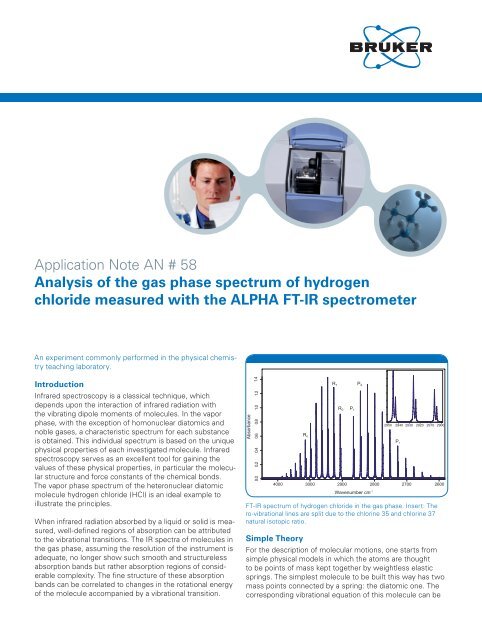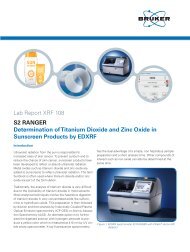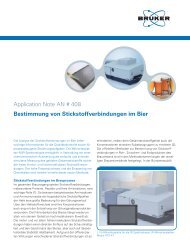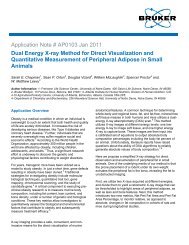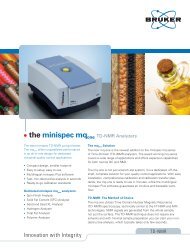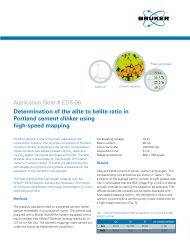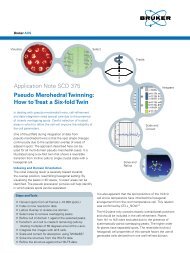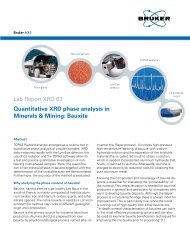Application Note AN # 58 Analysis of the gas phase ... - Bruker
Application Note AN # 58 Analysis of the gas phase ... - Bruker
Application Note AN # 58 Analysis of the gas phase ... - Bruker
Create successful ePaper yourself
Turn your PDF publications into a flip-book with our unique Google optimized e-Paper software.
<strong>Application</strong> <strong>Note</strong> <strong>AN</strong> # <strong>58</strong><strong>Analysis</strong> <strong>of</strong> <strong>the</strong> <strong>gas</strong> <strong>phase</strong> spectrum <strong>of</strong> hydrogenchloride measured with <strong>the</strong> ALPHA FT-IR spectrometerAn experiment commonly performed in <strong>the</strong> physical chemistryteaching laboratory.IntroductionInfrared spectroscopy is a classical technique, whichdepends upon <strong>the</strong> interaction <strong>of</strong> infrared radiation with<strong>the</strong> vibrating dipole moments <strong>of</strong> molecules. In <strong>the</strong> vapor<strong>phase</strong>, with <strong>the</strong> exception <strong>of</strong> homonuclear diatomics andnoble <strong>gas</strong>es, a characteristic spectrum for each substanceis obtained. This individual spectrum is based on <strong>the</strong> uniquephysical properties <strong>of</strong> each investigated molecule. Infraredspectroscopy serves as an excellent tool for gaining <strong>the</strong>values <strong>of</strong> <strong>the</strong>se physical properties, in particular <strong>the</strong> molecularstructure and force constants <strong>of</strong> <strong>the</strong> chemical bonds.The vapor <strong>phase</strong> spectrum <strong>of</strong> <strong>the</strong> heteronuclear diatomicmolecule hydrogen chloride (HCl) is an ideal example toillustrate <strong>the</strong> principles.When infrared radiation absorbed by a liquid or solid is measured,well-defined regions <strong>of</strong> absorption can be attributedto <strong>the</strong> vibrational transitions. The IR spectra <strong>of</strong> molecules in<strong>the</strong> <strong>gas</strong> <strong>phase</strong>, assuming <strong>the</strong> resolution <strong>of</strong> <strong>the</strong> instrument isadequate, no longer show such smooth and structurelessabsorption bands but ra<strong>the</strong>r absorption regions <strong>of</strong> considerablecomplexity. The fine structure <strong>of</strong> <strong>the</strong>se absorptionbands can be correlated to changes in <strong>the</strong> rotational energy<strong>of</strong> <strong>the</strong> molecule accompanied by a vibrational transition.FT-IR spectrum <strong>of</strong> hydrogen chloride in <strong>the</strong> <strong>gas</strong> <strong>phase</strong>. Insert: Thero-vibrational lines are split due to <strong>the</strong> chlorine 35 and chlorine 37natural isotopic ratio.Simple TheoryFor <strong>the</strong> description <strong>of</strong> molecular motions, one starts fromsimple physical models in which <strong>the</strong> atoms are thoughtto be points <strong>of</strong> mass kept toge<strong>the</strong>r by weightless elasticsprings. The simplest molecule to be built this way has twomass points connected by a spring: <strong>the</strong> diatomic one. Thecorresponding vibrational equation <strong>of</strong> this molecule can be
obtained by classical mechanics; <strong>the</strong> solution is representedby a sinusoidal motion <strong>of</strong> two masses at a frequency determinedby <strong>the</strong>ir masses and <strong>the</strong> restoring force <strong>of</strong> <strong>the</strong> spring.During <strong>the</strong> vibration <strong>the</strong> potential and <strong>the</strong> kinetic energy<strong>of</strong> <strong>the</strong> system continually interconvert but <strong>the</strong> sum <strong>of</strong> bo<strong>the</strong>nergies keeps constant as in a pendulum.V=1J=4J=3J=2J=1J=0J=4V=0J=3J=2J=1J=0Figure 1Energyv = 3v = 2v = 1E = 7/2 hνE = 5/2 hνE = 3/2 hνVibrational and rotational energy levels for a diatomic molecule suchas HCl. The spacing between V=0 and V=1 is much more thandepicted. The R branch ro-vibrational lines are shown on <strong>the</strong> left and<strong>the</strong> P branch ro-vibrational lines are shown on <strong>the</strong> right. Only <strong>the</strong> firstfew J levels are shown.Where E v is <strong>the</strong> energy <strong>of</strong> <strong>the</strong> vibrational state with quantumnumber v, ν is <strong>the</strong> classical vibrational frequency and h isPlanck’s constant. v takes integer values starting from 0.Figure 2Figure 1: Mechanical model <strong>of</strong> <strong>the</strong> vibrating diatomic molecule. k <strong>the</strong>spring constant corresponds to <strong>the</strong> molecular binding force, m 1andm 2are <strong>the</strong> atomic mass and r 0<strong>the</strong> equilibrium distance.Figure 2: The potential energy <strong>of</strong> <strong>the</strong> two mass model can be assumedto be a parabola, that is harmonic. The fur<strong>the</strong>r <strong>the</strong> masses aredisplaced from <strong>the</strong>ir equilibrium position, <strong>the</strong> higher <strong>the</strong> potentialenergy <strong>of</strong> <strong>the</strong> system.The resulting classical vibrational frequency <strong>of</strong> such an oscillatoris given by:For <strong>the</strong> description <strong>of</strong> <strong>the</strong> vibrational motion <strong>of</strong> a heteronucleardiatomic molecule, <strong>the</strong> quantum mechanical description<strong>of</strong> <strong>the</strong> harmonic oscillator can be used. The quantizedenergy levels are given by:E v = hν (v+½)v = 0E = 1/2 hνBond length1 kν =2πµ being <strong>the</strong> reduced mass.m 1 .m 2µ = m 1 + m 2Under normal conditions, <strong>the</strong> vibrational transitions takeplace from <strong>the</strong> ground state (v=0) to <strong>the</strong> first excited state(v=1). This simple vibrational model predicts just one singlevibrational band for a diatomic molecule. However, we canobserve a series <strong>of</strong> closely spaced bands as for <strong>the</strong> spectrum<strong>of</strong> HCl shown in <strong>the</strong> figure. These lines are due to <strong>the</strong>rotational sub- structure and a fur<strong>the</strong>r quantum number Jfor <strong>the</strong> rotational energy is introduced. J also takes integervalues starting from 0. So each vibrational level has astack <strong>of</strong> rotational levels and transitions occur from v=0 tov=1 with J changing by +1 (so called R branch lines) and Jchanging by –1 (so called P branch lines).The figure for <strong>the</strong> HCL spectrum shows a few exampleswhere lines are assigned and <strong>the</strong> number in brackets refersto <strong>the</strong> J number <strong>of</strong> <strong>the</strong> v=0 level. It turns out that <strong>the</strong> Qbranch line with no change in J and expected at <strong>the</strong> bandcentre is missing due to <strong>the</strong> operation <strong>of</strong> selection rules.This results in a gap between R(0) and P(1), see <strong>the</strong> figure.The rotational energies are given by BJ(J+1) where B isknown as <strong>the</strong> rotational constant. Knowledge <strong>of</strong> B leads to<strong>the</strong> molecular structure determination or in this simple case,<strong>the</strong> bond length. To a first approximation, <strong>the</strong> rotationalconstants B <strong>of</strong> <strong>the</strong> v=0 (lower) and v=1 (upper) vibrationallevels are determined as follows. For each J, take <strong>the</strong> differencesin cm -1 positions <strong>of</strong> <strong>the</strong> pairs <strong>of</strong> lines shown on <strong>the</strong>left side <strong>of</strong> <strong>the</strong> two equations and divide by (2J+1).R(J-1) – P(J+1) = 2B lower(2J+1)R(J) – P(J) = 2B upper(2J+1)
J R(J) P(J) R(J-1)-P(J+1)R(J)-P(J) 2J+1 2B(lower) 2B (upper) (2J+1)**20 2906.251 2925.9 2865.09 62.63 60.81 3 20.877 20.27 92 2944.92 2843.62 104.35 101.3 5 20.87 20.26 253 2963.29 2821.55 146 141.74 7 20.857 20.249 494 2981.01 2798.92 187.55 182.09 9 20.839 20.232 815 2998.05 2775.74 229 222.31 11 20.818 20.21 1216 3014.42 2752.01 270.29 262.41 13 20.792 20.185 1697 3030.1 2727.76 311.44 302.34 15 20.763 20.156 22<strong>58</strong> 3045.07 2702.98 352.39 342.09 17 20.729 20.123 2899 3059.32 2677.71 393.13 381.61 19 20.691 20.085 3612B estimateHCl-35 lower20.920.8520.820.7520.720.6520.620.550 100 200 300 400 500 600(2J+1)**210 3072.85 2651.94 433.6 420.91 21 20.648 20.043 44111 3085.66 2625.72 473.86 459.94 23 20.603 19.997 529Slope = -0.000530Intercept = 20.882212 2598.99J R(J) P(J) R(J-1)-P(J+1)0 2904.08R(J)-P(J) 2J+1 2B(lower) 2B (upper) (2J+1)**21 2923.71 2862.99 62.52 60.72 3 20.84 20.24 92 2942.7 2841.56 104.17 101.14 5 20.834 20.228 253 2961.05 2819.54 145.75 141.51 7 20.821 20.216 494 2978.74 2796.95 187.24 181.79 9 20.804 20.199 815 2995.76 2773.81 228.62 221.95 11 20.784 20.177 1216 3012.11 2750.12 269.84 261.99 13 20.757 20.153 1692B estimateHCl-35 upper20.320.2520.220.1520.120.052019.950 100 200 300 400 500 600(2J+1)**27 3027.76 2725.92 310.9 301.84 15 20.727 20.123 22<strong>58</strong> 3042.72 2701.21 351.76 341.51 17 20.692 20.089 2899 3056.92 2676 392.44 380.92 19 20.655 20.048 361Slope = -0.000524Intercept = 20.274010 3070.51 2650.28 432.79 420.23 21 20.609 20.011 44111 2624.13 23 529B = Rotational constant; Delta J = +1 is <strong>the</strong> R branch, Delta J = -1 is<strong>the</strong> P branchThis can be done for both chlorine isotopes (Cl-35 and Cl-37), see next two tables.Extended <strong>the</strong>oryInspection <strong>of</strong> <strong>the</strong> B constants determined in this simple wayshows a distinct curvature with J number. This arises from<strong>the</strong> neglect <strong>of</strong> <strong>the</strong> centrifugal distortion <strong>of</strong> <strong>the</strong> HCl molecule,which increases with J rotational quantum number. Themolecule stretches at higher rotational energy causing itsmoment <strong>of</strong> inertia I to increase. B is inversely related to <strong>the</strong>moment <strong>of</strong> inertia, so B decreases with J.Also B has a slightly lower value in <strong>the</strong> upper (v=1) vibrationalstate.<strong>Note</strong> : I = µr 2 where µ= reduced mass and r = internucleardistanceµ = M HM Cl/(M H+ M CL) where M = atomic massesMore detailed <strong>the</strong>ory leads to <strong>the</strong> revised equations:R(J-1) – P(J+1) = (2B lower– 3D lower)(2J+1) – D lower(2J+1) 3R(J) – P(J) = (2B upper– 3D upper)(2J+1) – D upper(2J+1) 3Where D = centrifugal distortion constant, which has asmall value2B estimateSlope = -0.000536Intercept = 20.84722B estimateHCl-37 lower20.920.8520.820.7520.720.6520.620.550 100 200 300 400 500(2J+1)**2HCl-37 upper20.320.2520.220.1520.120.052019.950 100 200 300 400 500(2J+1)**2Slope = -0.000530Intercept = 20.2422A plot <strong>of</strong> <strong>the</strong> previously determined 2B values versus (2J+1) 2 willresult in a straight line. The slope will be –D and <strong>the</strong> intercept (2B-3D).Calculation <strong>of</strong> <strong>the</strong> internuclear distanceExtrapolate <strong>the</strong> rotational constants to <strong>the</strong> equilibriumstate when <strong>the</strong> molecule would reside hypo<strong>the</strong>tically at <strong>the</strong>bottom <strong>of</strong> <strong>the</strong> potential well.
HCL-35 Literature HCL-37B lower 10.442 10.440254 10.424B upper 10.138 10.136228 10.122D lower 0.00053 0.00052828 0.000536D upper 0.000524 0.00052157 0.00053Values in cm -1Literature values for HCl-35 taken from very high resolution spectroscopy –Journal <strong>of</strong> Molecular Spectroscopy, vol. 17, 1965, p. 122.B lower= B equilibrium– 0.5 αB upper= B equilibrium– 1.5 αHCL-35HCL-37B equilibrium 10.594 10.576alpha 0.304 0.302Where α = vibration – rotation interaction constant (α =alpha in <strong>the</strong> table)The moment <strong>of</strong> inertia I is given by:I = 16.8575/B where B is in units <strong>of</strong> cm -1 and I has units <strong>of</strong>amu Angstroms 2 (1 Angstrom = 10 -8 cm). The number inthis equation derives from <strong>the</strong> quantity h/8π 2 c where c =velocity <strong>of</strong> light.Assuming an harmonic oscillator, <strong>the</strong> band origins forHCl-35 and HCl-37 are related by:V 0-1(HCl-37) = V 0-1(HCl-35) * √ (reduced mass HCl-35/reduced mass HCl-37)Using values <strong>of</strong> <strong>the</strong> reduced mass for HCl-35 and HCl-37from <strong>the</strong> table, <strong>the</strong> prediction for HCl-37 is 2883.78 cm -1compared with <strong>the</strong> experimental value <strong>of</strong> 2883.84 cm -1 .ConclusionsHCL-35HCL-37eqn 1 2885.97 2883.84eqn 2 2885.97 2883.84Values in cm -1 , literature value for HCl-35 is 2885.9775 cm -1 , J. Mol.Spectroscopy vol. 17, 1965, p.122The ALPHA is a compact and affordable FT-IR spectrometerthat makes it ideal for teaching applications as well as QA/QC. With <strong>the</strong> high resolution option for <strong>the</strong> ALPHA, excellentspectra <strong>of</strong> HCl vapor measured in a <strong>gas</strong> cell can beobtained. <strong>Analysis</strong> <strong>of</strong> <strong>the</strong> HCl spectrum, making full use <strong>of</strong><strong>the</strong> OPUS peak pick s<strong>of</strong>tware installed on <strong>the</strong> ALPHA PC orLaptop, yields molecular constants entirely consistent withvalues published in <strong>the</strong> spectroscopic research literature.These excellent experimental results are possible because<strong>of</strong> <strong>the</strong> good line shape, signal to noise and precise frequencyregistration <strong>of</strong> <strong>the</strong> ALPHA FT-IR spectrometer line.The literature value for <strong>the</strong> HCl equilibrium bond length measuredby microwave spectroscopy is 1.27455 Angstroms(Phys. Rev., vol 136, A1229, (1964)). Theoretically <strong>the</strong>sebond length values for HCl-35 and HCl-37 should be <strong>the</strong>HCL-35HCL-37B equilibrium 10.594 10.576I (amu Angstroms**2) 1.5912 1.594Reduced mass (amu) 0.979569 0.981054Internuclear distance(Angstroms)1.2745 1.2747same. This experiment with <strong>the</strong> ALPHA FT-IR spectrometershows excellent agreement with <strong>the</strong>se facts.Derivation <strong>of</strong> <strong>the</strong> vibrational band origin V 0-1V 0-1= R(0) – (2B upper– 4D upper) equation 1V 0-1= P(1) + (2B lower– 4D lower) equation 2The effect <strong>of</strong> D can be neglected.Prediction <strong>of</strong> <strong>the</strong> vibrational isotopic shiftwww.bruker.com/optics <strong>Bruker</strong> Optics Inc.<strong>Bruker</strong> Optik GmbH<strong>Bruker</strong> Hong Kong Ltd.Billerica, MA · USAPhone +1 (978) 439-9899Fax +1 (978) 663-9177info@brukeroptics.comEttlingen · GermanyPhone +49 (7243) 504-2000Fax +49 (7243) 504-2050info@brukeroptics.deHong KongPhone +852 2796-6100Fax +852 2796-6109hk@brukeroptics.com.hk<strong>Bruker</strong> Optics is continually improving its products and reserves <strong>the</strong> right to change specifications without notice.© 2011 <strong>Bruker</strong> Optics BOPT-4000353-01


